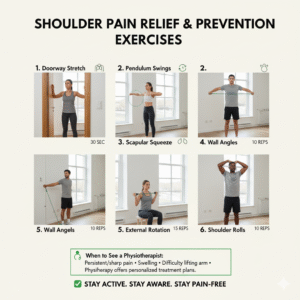
The shoulder is one of the most flexible and frequently used joints in the body. Whether you’re reaching for something on a shelf, typing on a computer, or lifting weights, your shoulder muscles and tendons are constantly in motion. But with this wide range of movement comes vulnerability—shoulder pain is one of the most common musculoskeletal complaints.
Understanding the causes of shoulder pain and learning how to prevent injuries can help you maintain mobility, avoid discomfort, and protect your long-term joint health.
🩻 1. Poor Posture
Cause: Sitting or standing with rounded shoulders and a forward head posture puts stress on the shoulder and neck muscles. Over time, this can cause muscle imbalance and shoulder impingement.
Prevention Tips:
Sit with your back straight and shoulders relaxed but not slouched.
Keep your computer screen at eye level.
Perform posture correction exercises such as shoulder blade squeezes and chin tucks.
💡 Consistent posture checks throughout the day can make a big difference.
🏋️ 2. Overuse or Repetitive Strain
Cause: Repetitive activities like lifting, painting, typing, or sports that involve overhead movement (like swimming or tennis) can lead to muscle fatigue and inflammation in the shoulder tendons.
Prevention Tips:
Take regular breaks during repetitive tasks.
Warm up before exercise or work involving your arms.
Strengthen your shoulder and upper back muscles to improve endurance and support.
⚾ 3. Rotator Cuff Injuries
Cause: The rotator cuff is a group of muscles and tendons that stabilize the shoulder joint. Tears or inflammation (tendinitis) in these tissues can cause pain, weakness, and limited movement.
Prevention Tips:
Do strengthening exercises like external rotations with resistance bands.
Avoid lifting heavy objects overhead without proper technique.
Seek physiotherapy if you experience persistent pain or limited motion.
🩺 Early physiotherapy can prevent small injuries from turning into chronic pain.
💼 4. Frozen Shoulder (Adhesive Capsulitis)
Cause: This condition involves stiffness and pain in the shoulder joint that gradually worsens over time, often after an injury, surgery, or prolonged immobilization.
Prevention Tips:
Keep your shoulder gently active even after minor injuries (as advised by your physiotherapist).
Perform range-of-motion exercises like pendulum swings and wall climbing stretches.
Manage underlying conditions like diabetes, which can increase your risk.
🧍♀️ 5. Muscle Imbalance and Weakness
Cause: Weakness in the upper back or shoulder stabilizers forces other muscles to overcompensate, leading to strain and discomfort.
Prevention Tips:
Strengthen your upper back, shoulder stabilizers, and core muscles.
Avoid focusing only on chest workouts—balance push and pull exercises.
Try physiotherapy-guided strengthening routines for better alignment.
🩹 6. Arthritis and Degenerative Changes
Cause: With age, the shoulder joint cartilage can wear down, causing stiffness, pain, and reduced range of motion.
Prevention Tips:
Stay physically active to maintain joint mobility.
Perform gentle stretching and low-impact exercises like swimming or yoga.
Maintain a healthy weight to reduce joint stress.
🧘♂️ Simple Shoulder Exercises for Prevention
Shoulder Rolls: Roll your shoulders forward and backward 10 times to release tension.
Wall Angels: Stand against a wall and slide your arms up and down like a snow angel—great for posture.
Doorway Stretch: Stand in a doorway with elbows bent and hands on the frame, then gently lean forward to open the chest and stretch the shoulders.
Scapular Squeeze: Pull your shoulder blades together, hold for 5 seconds, and release. Repeat 10 times.
🩺 When to See a Physiotherapist
Seek professional help if you experience:
Persistent or sharp pain lasting more than a few days.
Swelling or redness around the joint.
Difficulty lifting your arm or performing daily activities.
A physiotherapist can diagnose the root cause, design a personalized exercise plan, and use techniques like manual therapy, ultrasound, or dry needling for recovery.
✅ Conclusion
Shoulder pain can result from poor posture, overuse, or underlying conditions—but most cases are preventable. Maintaining good posture, taking regular breaks, and performing strengthening exercises can help you stay pain-free.
🏋️♂️ Remember: prevention is easier than treatment. Stay active, stay aware, and seek physiotherapy early if pain persists.

